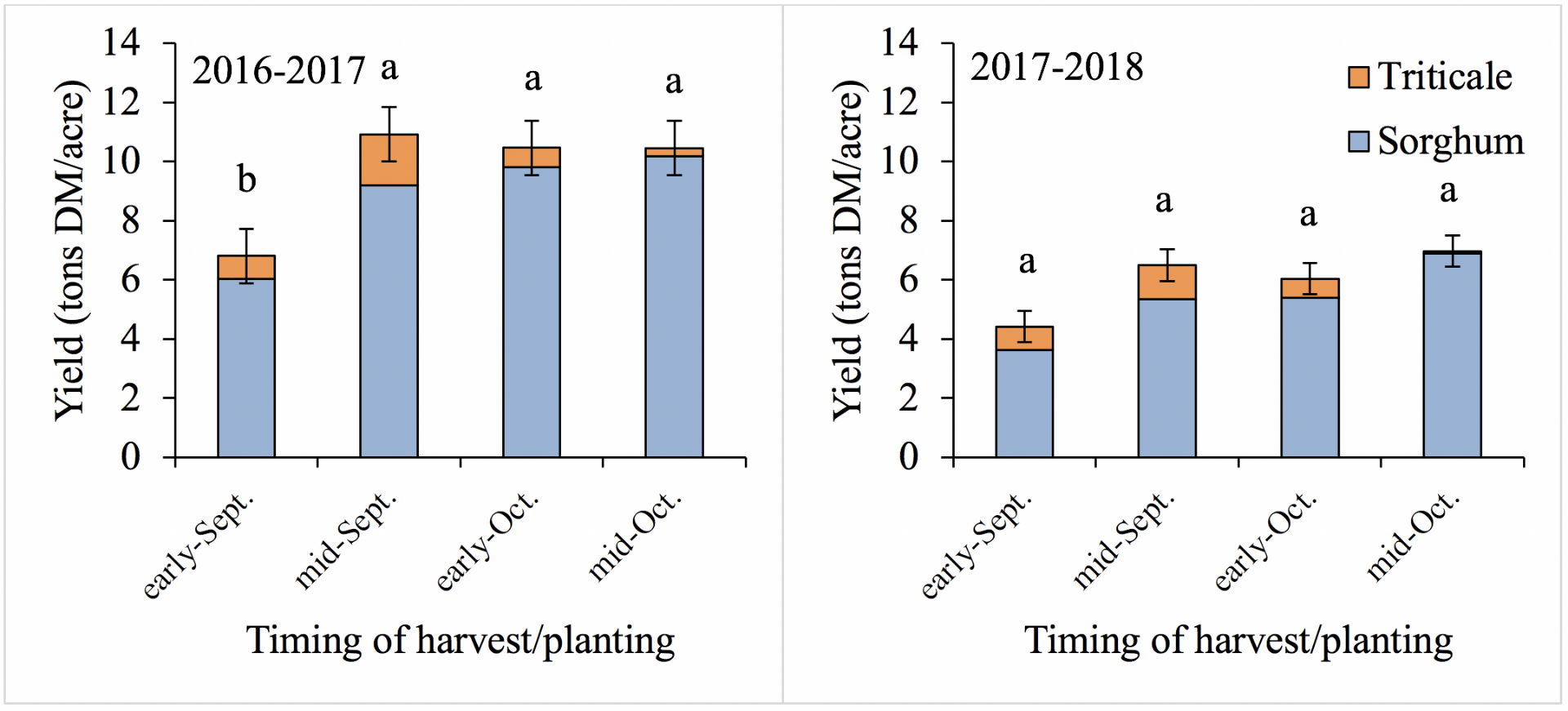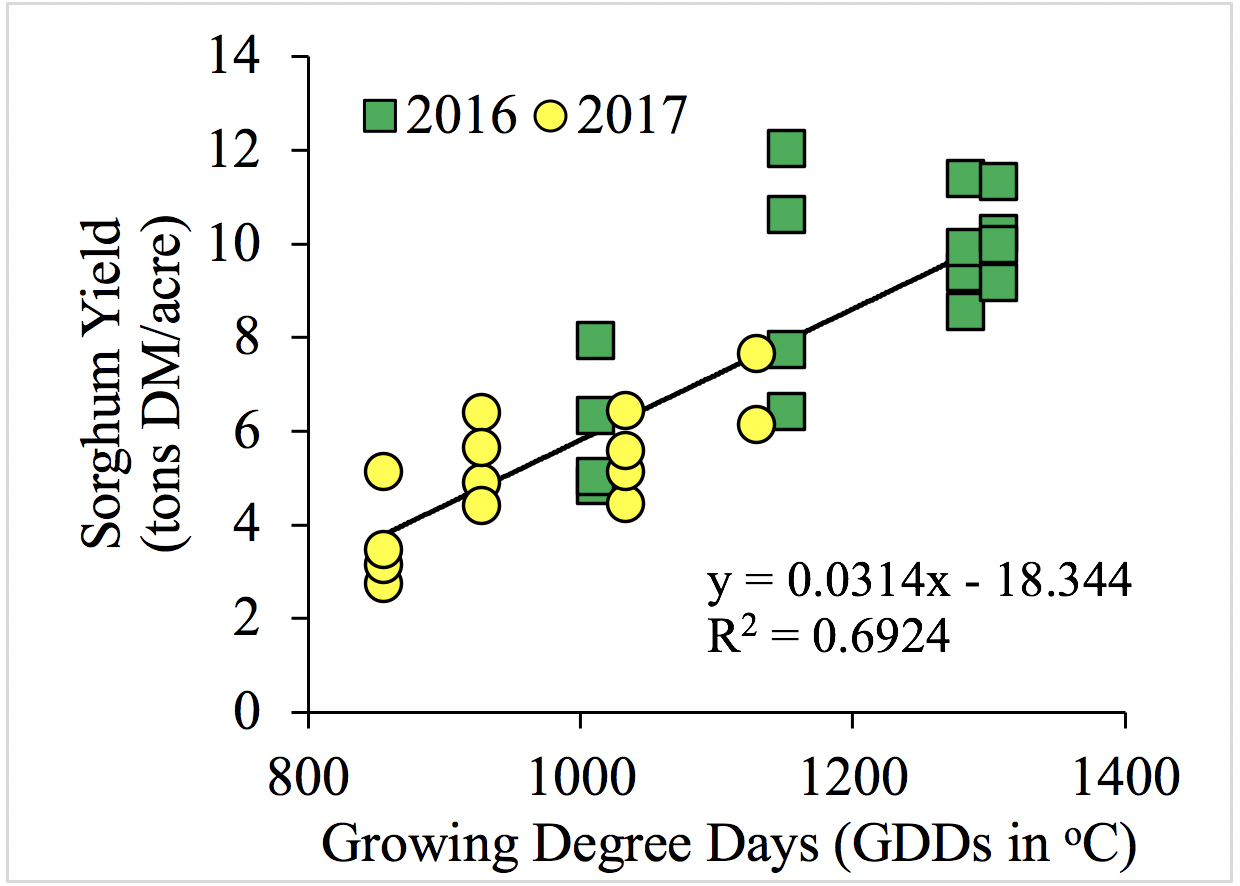Sarah E. Lyonsa*, Quirine M. Ketteringsa, Greg Godwina, Jerome H. Cherneyb, Debbie J. Cherneyc, John J. Meisingerd and Thomas F. Kilcere
aNutrient Management Spear Program, Department of Animal Science, Cornell University, Ithaca, NY, bSoil and Crop Sciences Section of the School of Integrative Plant Science, Cornell University, Ithaca, NY, cDepartment of Animal Science, Cornell University, Ithaca, NY, dUSDA-ARS Beltsville Agricultural Research Center, Beltsville, MD (retired), eAdvanced Agricultural Systems, LLC, Kinderhook, NY. *Current affiliation: Department of Crop and Soil Sciences, North Carolina State University, Raleigh, NC
Introduction
Double cropping with both warm- and cool-season forages in New York can have many benefits, including providing a source of forage yield in the spring potentially leading to greater total season yields than a monocrop system, increasing rotation diversity, and providing year-round soil cover. Winter cereals such as triticale are great options for double cropping in the northeast, as they overwinter and can produce high forage yields in the spring. Yet, depending on weather and growing season condition, a winter cereal crop harvested for forage can delay corn silage planting to mid-May or later. Sorghum is a potentially useful alternative to corn silage for double cropping rotations as sorghum can be planted later than corn. While it is possible to harvest forage sorghum earlier than the recommended soft dough growth stage without compromising yield (Lyons et al., 2019a), it was not known how sorghum harvest timing would impact total season yield of both forage crops in the rotation. Here we present the findings of a field trial to evaluate the impact of sorghum harvest timing on the combined yield of forage triticale and forage sorghum in a double cropping rotation.
Field Research
This double cropping study with forage sorghum (brachytic dwarf brown midrib variety ‘AF7102’) and forage triticale (‘Trical 815’) was conducted at the Musgrave Research Farm in Aurora, NY from October 2015 to June 2018. The study was initiated with triticale planting in mid-October, 2015. Each spring, the triticale received multiple rates of nitrogen (N) at dormancy break in mid- to late-April and was harvested in mid- to late-May at flag-leaf stage. Sorghum was planted between early and mid-June once the soil temperature stayed consistently above 60°F. Sorghum received either no N or 200 lbs N/acre at planting, and was harvested four times in the fall between early September and mid-October, approximately 2 weeks apart. Triticale was planted a day after sorghum harvest. Here we present the data from the plots that received 120 lbs N/acre for triticale and 200 lbs N/acre for sorghum, where N supply was not expected to limit yield of either crop.
Results
In 2016, sorghum yield was highest when harvested after mid-September (late-flower to early-milk growth stage or later), and the following triticale yield was highest when planted in mid-September (Figure 1). Because of the larger contribution that sorghum had, overall total season yield did not increase after the mid-September sorghum harvest and triticale planting date that year. In the second year of the study (fall 2017-spring 2018), sorghum yield was maximized at the last harvest date, and, as with the year before, triticale yielded highest when planted in mid-September. Total season yields were lower in the second year compared to the first year, most likely reflecting weather; fall 2016 was warmer and drier, while fall 2017 was cooler with higher rainfall. There were more growing degree days (GDDs) by mid-September 2016 than by the last harvest in mid-October 2017 (Figure 2).


Conclusions and Implications
Forage double cropping can be both economically and environmentally beneficial in upstate New York. Sorghum, a crop well-adapted to warm and dry climates, planted in early or mid-June will likely reach maximum yields earlier in years with more GDD (by 1151 GDD in oC or 2072 GDD in oF in mid-September 2016 in this study) compared to years with fewer GDD (such as 2017 in this study). We recommend that sorghum grown in New York during warm, dry years can be harvested once ~1150 GDD (°C scale; 2070 GDD in oF scale) have accumulated. This can support both sorghum and triticale yields. If 1150 GDD have not accumulated by the soft-dough growth stage (cool, wet years), harvesting sorghum at soft dough is recommended to maximize total season yield.
Additional Resources
-
- Lyons, S.E., Q.M. Ketterings, G. Godwin, D.J. Cherney, J.H. Cherney, M.E. Van Amburgh, J.J. Meisinger, and T.F. Kilcer. 2019a. Best timing of harvest for brown midrib forage sorghum yield, nutritive value, and ration performance. What’s Cropping Up? 29(3): 42-43.
- Lyons, S.E., Q.M. Ketterings, G. Godwin, D.J. Cherney, J.H. Cherney, J.J. Meisinger, and T.F. Kilcer. 2019b. Nitrogen management of brown midrib forage sorghum in New York. What’s Cropping Up? 29(1):1-3.
- Lyons, S.E., Q.M. Ketterings, S. Ort, G.S. Godwin, S.N. Swink, K.J. Czymmek, D.J. Cherney, J.H. Cherney, J.J. Meisinger, and T. Kilcer. 2019c. Nitrogen management for forage winter cereals in New York. What’s Cropping Up? 29 (3): 44-45.
Full Citation
The information summarized here comes from a 2019 publication in the Agronomy Journal: Lyons, S.E., Q.M. Ketterings, G.S. Godwin, J.H. Cherney, D.J. Cherney, J.J. Meisinger, and T.F. Kilcer (2019). Double-cropping with forage sorghum and forage triticale in New York. Agronomy Journal 111:3374-3382. doi:10.2134/agronj2019.05.0386.
Acknowledgements
 This work was supported by Federal Formula Funds, and grants from the New York Farm Viability Institute (NYFVI) and Northeast Sustainable Agriculture Research and Education (NESARE). For questions about these results, contact Quirine M. Ketterings at 607-255-3061 or qmk2@cornell.edu, and/or visit the Cornell Nutrient Management Spear Program website at: http://nmsp.cals.cornell.edu/
This work was supported by Federal Formula Funds, and grants from the New York Farm Viability Institute (NYFVI) and Northeast Sustainable Agriculture Research and Education (NESARE). For questions about these results, contact Quirine M. Ketterings at 607-255-3061 or qmk2@cornell.edu, and/or visit the Cornell Nutrient Management Spear Program website at: http://nmsp.cals.cornell.edu/

